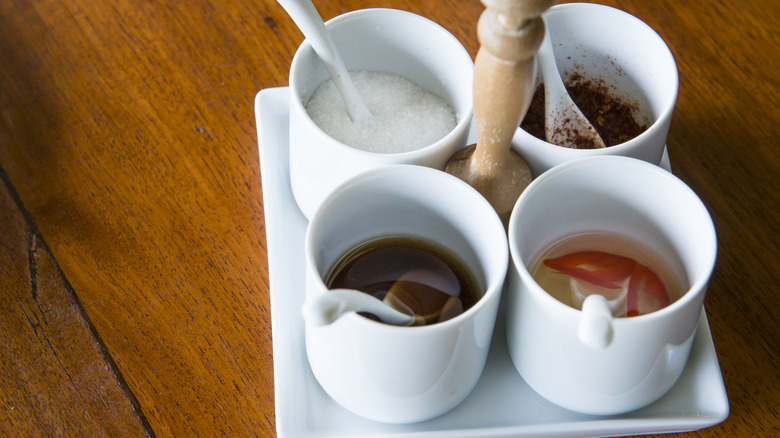What's The Difference Between Fish Sauce And Oyster Sauce?
If you're not well-versed with Asian cooking, the diversity of condiments can feel overwhelming. Peer into the condiment section of an Asian grocery store, and you'll be stunned by the enormous selection of soy sauces, vinegars, oils, pastes, and cooking wines. Each item offers a unique quality to a dish, and every sauce has a specific aromatic profile.
Take two Asian sauces that are associated with seafood: oyster and fish sauce. Both are incredibly useful, with each sauce packing in lots of contrasts despite sharing a marine-derived source. While fish sauce is a liquid with salty, savory, and pungent flavors, oyster sauce is instead a sweet and dense mixture, with a pleasant shellfish taste. Additionally, the two condiments come from different cuisines, with fish sauce hailing from Southeast Asia and oyster sauce from China. Accordingly, they also come with their own distinct culinary applications. As both are pantry staples on Jet Tila's list of cooking essentials, understanding their nuances is key to crafting quality Asian dishes.
What is fish sauce?
Fish sauce is a wondrously aromatic liquid crafted by fermenting small fish — typically anchovies — in salt. The two ingredients are combined in a large container and left to ferment for at least six months. Over time, the two break down into a liquid. This liquid is then further reduced by the sun's heat, aged, and bottled. Many variations exist, with bottles from Vietnam and Thailand being particularly popular, but there are also versions from Japan, Korea, and Southern China. In fact, even the Ancient Romans used a fish sauce called garum.
The flavor of the condiment hits several senses. In addition to the expectedly prominent fishy, salty notes, the sauce contains both sweet and savory aromas. Aging makes the natural sweetness more pronounced and decreases the saline taste. It's a condiment that adds a multidimensional flavor, especially in combination with citrus, chilies, and sugar. Once exposed to heat, the fish sauce mellows out, losing its more abrasive qualities.
What is oyster sauce?
Thick, glossy, and sweet, oyster sauce is hard to mistake. As per its name, it is made from oysters cooked slowly with other ingredients until only a dense, sticky sauce remains. Reportedly, such a process came about as a mistake after a Chinese street food stall owner left an oyster soup to simmer for too long. When he sampled the product, the resulting sweet and savory notes impressed him, leading him to set up the now iconic oyster sauce brand Lee Kum Kee. Today, most producers follow a similar slow cooking process, but add in sugar, corn starch, and MSG to enhance the texture and flavor.
The condiment delivers an umami-rich taste that doesn't exactly call to mind oysters. Still, there is a seafood-like undertone to the condiment, with a palatable saltiness. However, expect an accompanying complex, caramel-like sweetness. The flavor is delicious as is, making it a great dipping sauce. And it'll meld well with other components in a sauce, adding an incredible touch to stir fries and marinades. It's most strongly intertwined with Chinese cooking, but it's also used in Southeast Asian cuisines like Vietnamese, Malay, and Thai.
Two divergent production methods
Craftily harnessing bacteria's ability to transform sugar into other tasty byproducts, fermentation is the essential process behind all alcohol production. For other food items, like kimchi, the reaction acts as a preservative, creating a complex array of flavors as well as protecting the dish from harmful bacteria. In addition to fish sauce, commonly used Asian condiments like soy sauce, mirin, miso, and rice vinegar are all fermented products. Fermentation is the cornerstone of the fish sauce taste, lending it a bold, complex flavor profile. This sets it clearly apart from oyster sauce, which is made in a completely different way.
This condiment instead relies on sauce reduction and caramelization to build flavor. As excess moisture is cooked off, a concentration of sugars, often with the help of starch, thickens the mixture from a liquid to a slurry. As a result, the oyster sauce is much denser, similar in consistency to a balsamic glaze or barbecue sauce. Oyster sauce still achieves a degree of umami flavor, but it's much less pungent in smell. Sugar is the foundational ingredient, making it a less funky foodstuff.
The many different culinary applications for fish and oyster sauce
With such distinct tastes and cultural backgrounds, it's no surprise the two condiments come with vastly different culinary uses. Cooking with fish sauce means you need to know how to harness its pungent, flavorful powers. In Thai cuisine, fish sauce is usually complemented by sweet, tangy, and even spicy ingredients. It's a foundational piece of dishes like Pad Thai — which also hinges on tamarind paste — as well as curries and soups. It can be used to marinate proteins or add flavor to a braise. Once combined with sugar, garlic, chilies, and citrus, it forms a common Vietnamese dipping sauce called Nước Chấm.
Oyster sauce is similarly intense in flavor, with only a spoonful needed to enhance marinades, braises, and stir fries. Unlike fish sauce, its sugary nature imparts an extra note of caramelization. The elixir is thrown into sauces that go on high heat, coating stir fried proteins like pork or chicken. It's especially common in Chinese cuisine, accentuating dishes like lo or chow mein, as well as sautéed vegetable dishes. It does share one key trait with fish sauce: It's an excellent base for a dipping sauce. Its unique character makes it ideal for creative riffs, imbuing everything from salad dressing to steak with a signature flavor.




